Key takeaways:
- Research impact extends beyond academic relevance, emphasizing real-world applications and community engagement.
- Evaluating research impact helps secure funding and fosters lasting partnerships with stakeholders.
- Qualitative metrics, such as stakeholder feedback and community narratives, are crucial for a comprehensive understanding of research outcomes.
- Engaging diverse community representatives from the outset strengthens research relevance and ensures aligned outcomes.
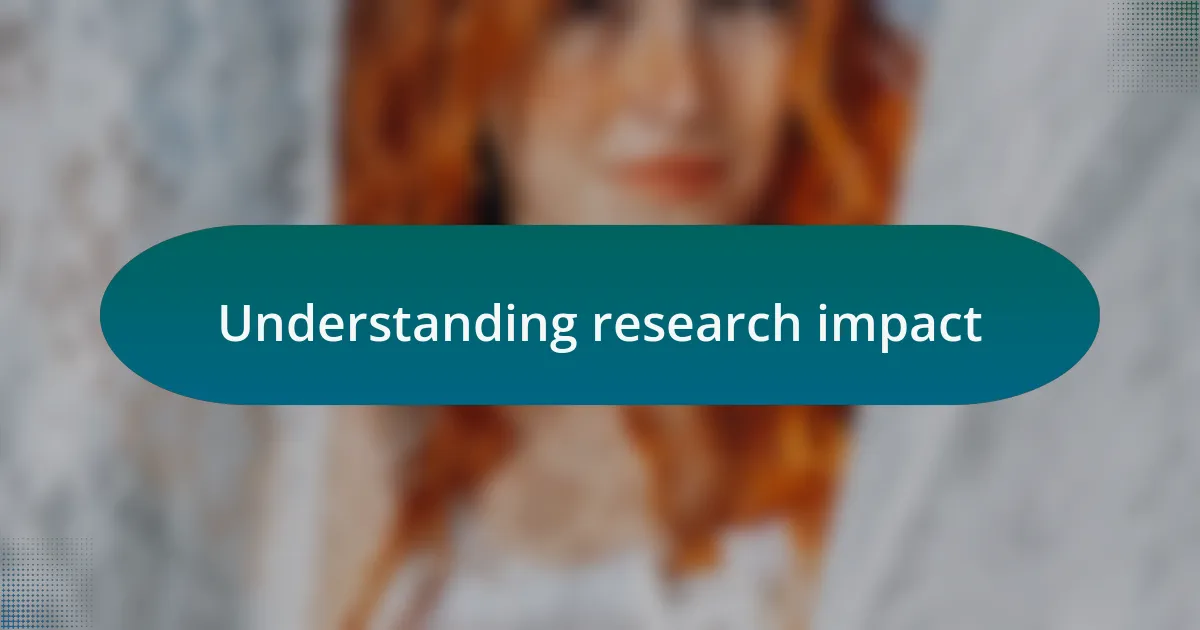
Understanding research impact
Research impact is often seen through the lens of its immediate academic relevance, but I believe it extends far beyond that. For instance, I once collaborated on a study that aimed to improve local healthcare practices. The joy of seeing our findings implemented in clinics, ultimately benefiting patients, made me realize that the true measure of research lies in its real-world application. How often do we consider the broader implications of our work?
When I think about research impact, I can’t help but reflect on those moments when I presented my findings to a community directly affected by my work. Their questions and engagement were a stark reminder that science isn’t just confined to labs and journals; it speaks to the needs and hopes of everyday people. This connection fosters a sense of responsibility—shouldn’t our research not only advance knowledge but also empower those who benefit from it?
Moreover, the influence of research can ripple through society, influencing policies, shaping public opinion, and driving innovation. I remember attending a town hall meeting where results from my study sparked a discussion on healthcare reform. Witnessing the potential of research to foster change left me questioning: Are we doing enough to ensure our research contributes positively to society? Understanding research impact means embracing this responsibility and striving to make a difference.
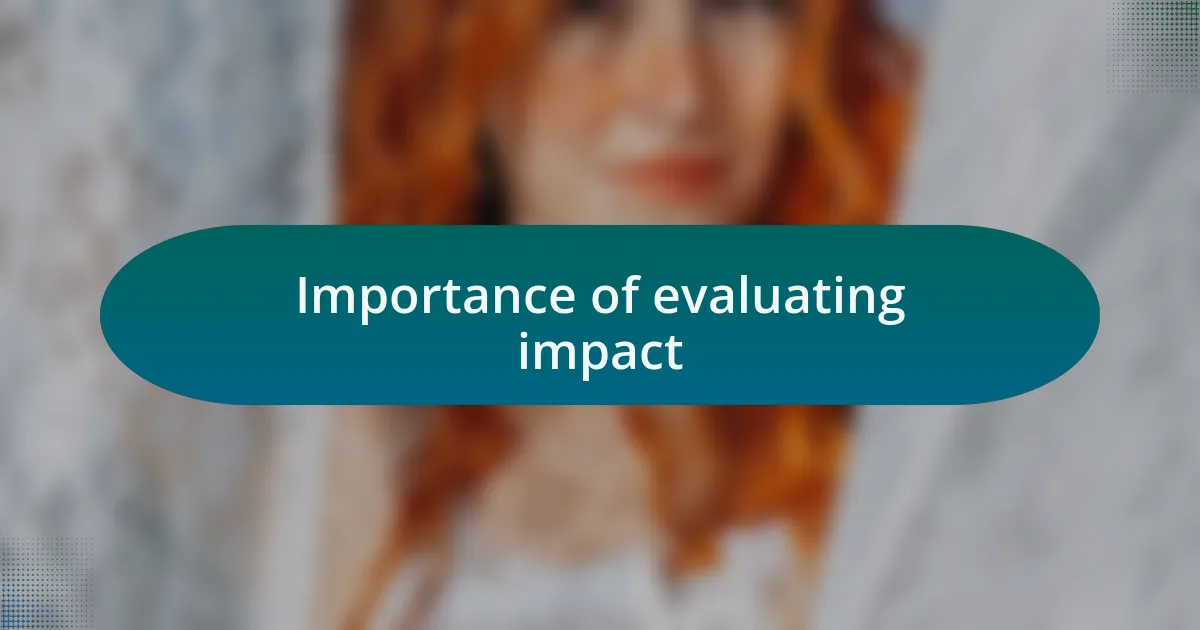
Importance of evaluating impact
Evaluating the impact of research is crucial as it helps us grasp the true value of our work beyond publication metrics. I remember evaluating a project concerning environmental sustainability; we were pleasantly surprised when our findings led to community-led initiatives that directly improved local ecosystems. This experience underscored for me that understanding impact isn’t just a checklist; it’s about witnessing our research spark real change and inspire collective action.
Another reason impact evaluation is important lies in its undeniable role in securing funding for future projects. Reflecting on a grant proposal I once worked on, the funders explicitly sought evidence of past impacts to gauge our potential for success. This taught me that showcasing the broader effects of previous research not only validates our efforts but also strengthens our case for resources necessary to continue our work. Isn’t it fascinating how one’s ability to articulate impact can open doors for future exploration?
Moreover, a well-evaluated impact can create lasting relationships with stakeholders. I vividly recall a partnership formed out of a simple report I produced. Its practical implications resonated with local decision-makers, leading to collaborative projects that have sustained well beyond our initial research timeline. This experience made me ponder: shouldn’t our aim be to forge enduring connections that ensure research remains relevant and responsive to community needs? By prioritizing impact evaluation, we nurture a culture of accountability and relevance that benefits everyone involved.

Common methods of evaluation
When it comes to evaluating research impact, one commonly used method is the survey. I have utilized surveys in various projects to gather direct feedback from participants and stakeholders. The insights gained can be profound; for instance, one survey I conducted revealed not just how individuals were affected by our research but also highlighted unexpected areas for improvement. Isn’t it eye-opening how a simple questionnaire can uncover so much?
Another method I often turn to is bibliometric analysis, which involves assessing research outputs through citations and publications. I remember analyzing the citation patterns of a specific study on public health interventions. The results not only illustrated the reach of the research but also pointed to specific areas where our work sparked further inquiry. This approach emphasizes that numbers, when interpreted thoughtfully, can tell a compelling story about a study’s influence.
Finally, case studies serve as a powerful evaluation tool because they provide in-depth looks at specific instances of impact. In one of my own research endeavors, we followed up with communities several years after implementing a health program. The stories shared with me during those follow-ups were nothing short of inspiring; they reflected lasting changes in behavior and lifestyle. Have you ever considered the emotional depth that such narratives can add to your impact evaluation? It’s moments like these that remind us of the tangible effects our research can have.
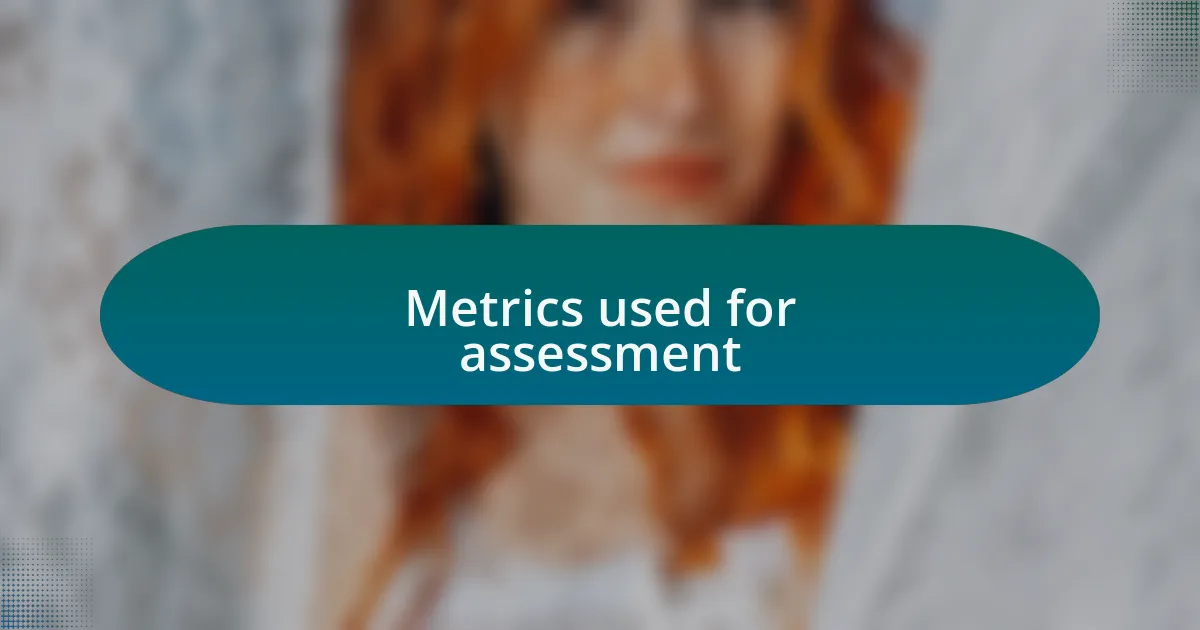
Metrics used for assessment
When evaluating research impact, one noteworthy metric is the Altmetric Attention Score, which measures the online attention a piece of research garners. I recall one of my studies receiving a surprisingly high score, driven primarily by social media shares and blog mentions. It was fascinating to see how public interest could elevate the visibility of our work beyond academic circles. Have you considered how much influence can stem from a single tweet or post?
Another key metric I frequently use is the h-index, which combines both productivity and citation impact of researchers. I personally analyze my own h-index regularly; it serves as a reflection of my career’s influence in the academic community. This multidimensional view not only tracks my progress but also prompts me to ask: How can I create work that truly resonates and leads to meaningful citations? Such introspection is invaluable in guiding future research directions.
Finally, engagement metrics like downloads and views of research articles provide practical insights into how widely a study is accessed. I once had a paper that, despite low citation rates, saw a high number of downloads in educational settings. That made me curious—could it be that while my research wasn’t heavily cited, it was still shaping conversations and informing practices among educators? Such discoveries remind me that the impact of research can extend beyond traditional academic measures.

Personal criteria for evaluation
When I assess the impact of my research, I often reflect on its real-world applicability. I remember a project where our findings were implemented in community health initiatives. The feedback we received from local stakeholders was incredibly rewarding, making me realize that research isn’t just about numbers; it’s about tangible change. How often do we pause to evaluate if our work is creating a meaningful difference?
Another criterion I focus on is interdisciplinary collaboration. I find it thrilling when my research opens doors to conversations with experts in different fields. For instance, after collaborating with environmental scientists, I discovered new perspectives that enriched my work. It made me wonder—are we limiting our research impact by not reaching out beyond our immediate disciplines?
Lastly, peer feedback plays a significant role in my evaluation process. I cherish moments when colleagues provide constructive criticism that challenges my viewpoint. One experience I had involved a manuscript that, after several revisions from peers, became a much stronger paper. It’s interesting to consider—how can we encourage more open dialogues that enhance the quality of our research? This kind of engagement fosters a culture of continuous improvement, which I see as essential for impactful scholarship.
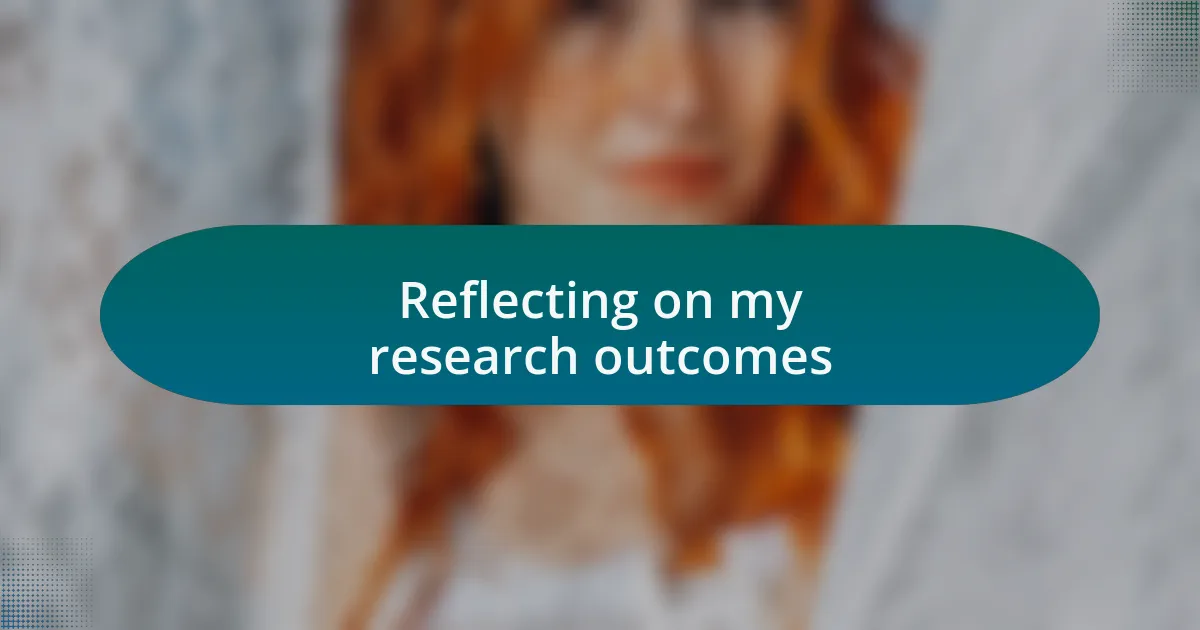
Reflecting on my research outcomes
Reflecting on my research outcomes often reveals unexpected lessons. I recall a study on renewable energy solutions where, initially driven by data alone, I didn’t pay enough attention to community perspectives. When I later shared our findings with local residents, their insights enriched the narrative in ways I hadn’t anticipated. It dawned on me that the true impact of research can be shaped by listening as much as by analyzing. How often do we overlook the voices that could elevate our work?
One of my most profound reflections came after researching educational interventions. I thought I had the best strategies laid out for improving student outcomes, but the real measure of success was the stories of individual students who thrived. Those narratives brought the data to life and made it clear that the human element is irreplaceable. Don’t we owe it to ourselves to dig deeper into the stories that lie behind our findings?
There’s also something transformative about revisiting past projects years later. I was taken aback when a social initiative I thought had faded away resurfaced in community discussions. Hearing how our research influenced local policy sparked a sense of pride and humility in me. It made me wonder—what enduring impacts do we sometimes miss in the hustle of publishing? Exploring these outcomes can lead to a richer understanding of our role in the scientific landscape.
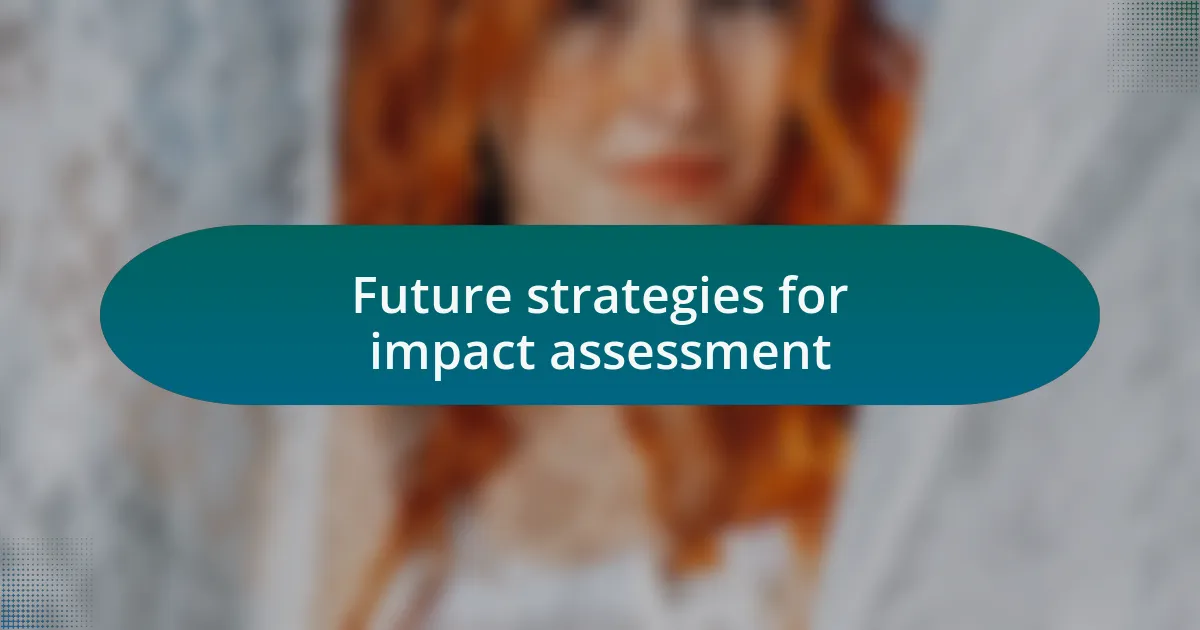
Future strategies for impact assessment
As I think about future strategies for assessing the impact of research, I notice the growing importance of integrating qualitative metrics with traditional quantitative measures. For instance, I recently implemented a feedback loop where we engaged stakeholders directly after project completion, rather than relying solely on surveys. This change revealed richer narrative insights—stories we never considered capturing previously—showing me that numbers alone can’t tell the full story. Have we ever truly recognized the depth of qualitative data in shaping our understanding of research impacts?
One emerging method that excites me is using digital tools to track long-term engagement and influence. I recall a project focused on environmental policy, where we utilized social media analytics to gauge public discourse around our findings over time. The data we gathered revealed patterns that traditional assessments overlooked. It made me realize how online conversations can illuminate ongoing impacts and shifts in public perception—what if more researchers tapped into these resources for a holistic view of their work’s influence?
Moreover, involving diverse community representatives as partners from the outset is a strategy I find particularly promising. I once worked on a healthcare initiative where the community advisory board provided invaluable perspectives that we hadn’t anticipated. This collaboration not only refined our research approach but also ensured that our outcomes resonated with those most affected. How much stronger could our impact assessments become if we continuously engaged with those we aim to serve? This approach could reshape the entire landscape of research evaluation.